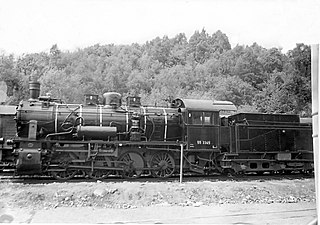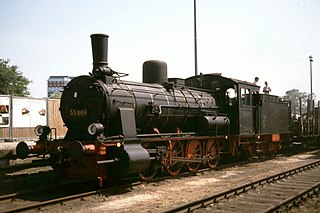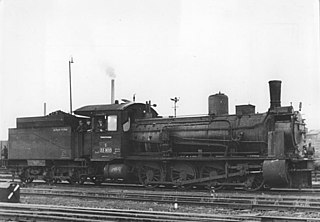
The Prussian G 8.1 was a heavier, stronger development of the G 8 and was initially referred to as a 'strengthened standard class'.

The Prussian G 12 is a 1'E 2-10-0 goods train locomotive built for the Prussian state railways.

The first steam locomotives of the Baden Class VI c were delivered in 1914 by the Maschinenbau-Gesellschaft Karlsruhe for service in southwestern Germany with the Grand Duchy of Baden State Railway.

The Prussian G 10 was a German goods train, steam locomotive, whose design was based on a combination of the running and valve gear from the Prussian T 16 and the boiler from the Prussian P 8. In developing the G 10, however, the T 16 running gear with side play on the first and fifth axles was modified. The T 16 was also subsequently built with this modified configuration and called the Prussian T 16.1. The G 10 was intended for heavy goods train duties on main lines, but as a result of its low axle load it could be employed more flexibly than its equally powerful cousin, the Prussian G 8.1. The G 10 was occasionally even used in passenger train service.
The Prussian T 13 was a series of tank locomotives built in large numbers for the various German state railways, notably the Prussian state railways, and the Deutsche Reichsbahn during the early part of the 20th century.
The Prussian G 12.1 was a German steam locomotive built for the Prussian state railways during the First World War and was the largest Prussian freight locomotive with a 2-10-0 wheel arrangement. It had three cylinders, the two outer ones driving the third axle and the inner one the second axle.
The Prussian Class G 4 were German, six-coupled, goods train, steam locomotives with a boiler pressure of 12 bar, built primarily for the Prussian state railways. Classified by the state railway in 1905, they included 16 locomotives from the railway division of Mainz, that originally came from the Hessian Ludwigsbahn. These earlier locomotives were delivered between 1872 and 1896 and did not meet the Prussian norms.

The Prussian Class P 6s were passenger locomotives operated by the Prussian state railways with a leading axle and three coupled axles.

The Prussian Class T 11 were passenger tank locomotives produced between 1903 and 1910 in the service of the Prussian state railways for duties on the Berlin Stadtbahn.

The Prussian Class T 10s were tank locomotives operated by the Prussian state railways. They were procured for duties between Frankfurt and Wiesbaden between 1909 and 1912. This 41-kilometre (25 mi) long route between the two termini was to be worked without turning the locomotive. Because the engine tended to derail, in practice it was turned whenever possible. On these engines, supplied by Borsig, the boiler from the Prussian P 6 and the running gear and drive from the Prussian P 8 were used. The boiler had to be positioned further forward than was usual on other locomotives in order to even out the distribution of weight, because the design omitted any trailing wheels. The first trial runs took place on 30 June 1909.

The Prussian Class G 7.1 engines of the Prussian state railways were German eight-coupled, goods train, steam locomotives.

The Prussian T 14s were German, 2-8-2T, goods train, tank locomotives operated by the Prussian state railways and the Imperial Railways in Alsace-Lorraine. They were later incorporated by the Deutsche Reichsbahn into their renumbering plan as Class 93.0–4.

The Saxon Class XI T were German, 0-10-0, tank locomotives with the Royal Saxon State Railways procured for goods train services. The Deutsche Reichsbahn grouped them in 1925 into their DRG Class 94.19-21.
The Prussian G 8.2 class of locomotives actually incorporated two different locomotive types: one was the Prussian/Oldenburg G 8.2, for which the Deutsche Reichsbahn subsequently issued follow-on orders; the other was the G 8.2 of the Lübeck-Büchen Railway.

The Prussian Class T 12 is an early, German, passenger train, tank locomotive built for the Prussian state railways in large numbers. These locomotives were superheated variants of the T 11.

The Prussian T16 locomotives were ten-coupled superheated freight tank locomotives of the Prussian State Railways. They were later renumbered in the 94.2–4 by Deutsche Reichsbahn

The Prussian G 7.2 was a class of 0-8-0 tender compound locomotives of the Prussian state railways. In the 1925 renumbering plan of Deutsche Reichsbahn, the former Prussian locomotives produced from 1895 to 1911 were given the class designation 55.7–13; while the locomotives of former Mecklenburgische Friedrich-Franz-Eisenbahn (MFFE) locomotives were classified as 55.57.
The Prussian G 5.3 was a class of 2-6-0 goods locomotives. They were the two-cylinder-simple version of the compound G 5.4. As with many Prussian locomotive design, simple and compound versions of the same type built. The G 5.3, like the G 5.4, differed from the G 5.1 and G 5.2 as it had a shorter wheelbase and a higher-pitched boiler. The Krauss-Helmholtz bogie was intended to improve the driving characteristics, especially at higher speeds. Production of the G 5.3 was from 1903 until 1906, and 206 units were built.
The Prussian G 5.2 was a class of two-cylinder compound goods locomotive introduced in 1895. As with many Prussian locomotive design, simple and compound versions of the same type were built – in this case the G 5.2 was the two-cylinder compound version of the simple G 5.1. The compound locomotives were more economical and more powerful than the simple locomotives; they were more suitable for long stretches with few stops. The newly introduced air brakes made it possible to use the G 5.2 on passenger trains, which the Prussian State Railways often did.
The Prussian G 4.3 was a class of 0-6-0 goods locomotive of the Prussian State Railways; they were manufactured between 1903 and 1907 by Union Giesserei in Königsberg. The type was developed with the aim of improving the running characteristics of 6-coupled locomotives. They proved a more capable design than the normal-type, and so had a higher maximum speed of 60 km/h (37 mph). However, they were quickly outclassed by increasing weight of freight trains.
















